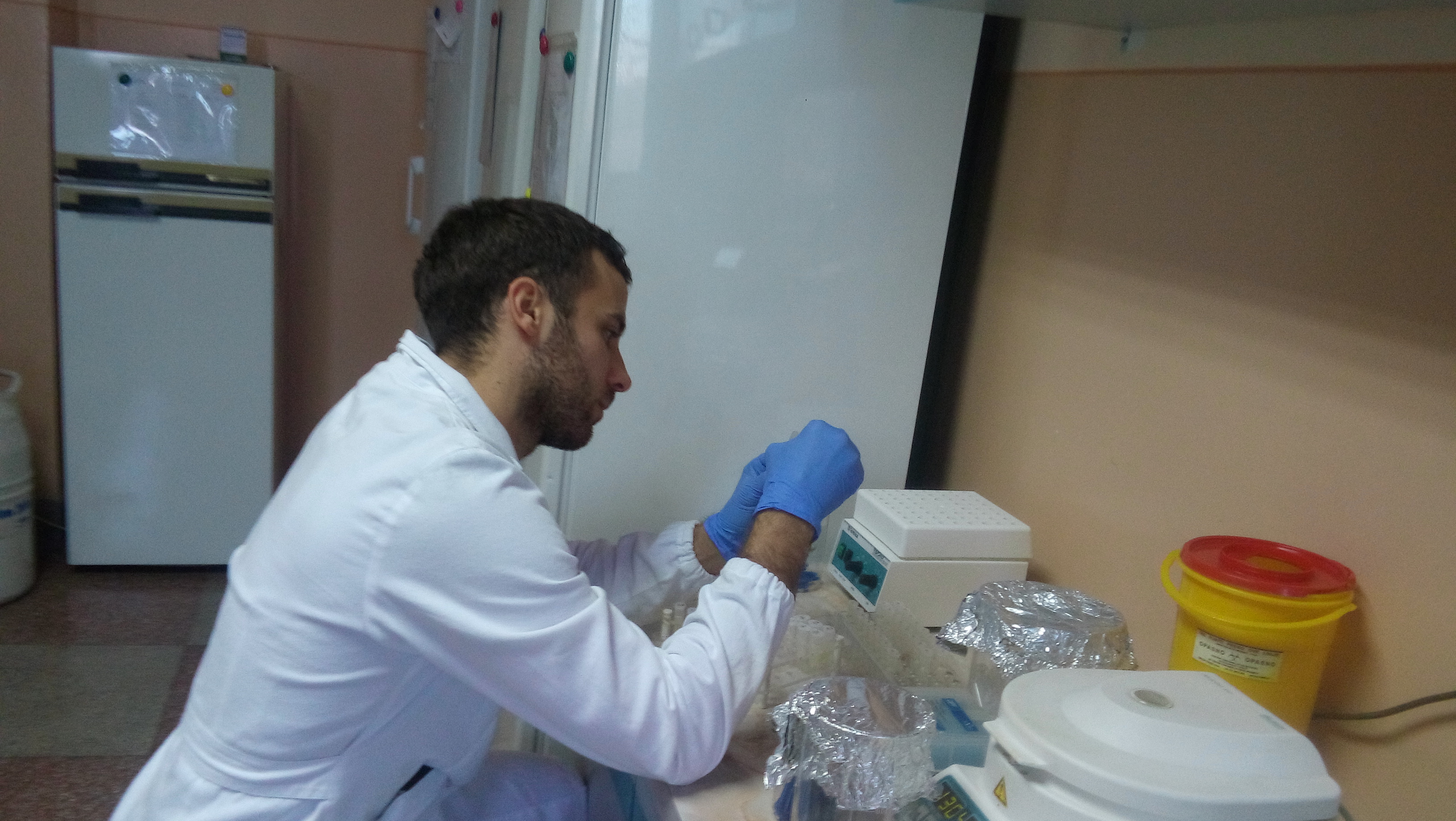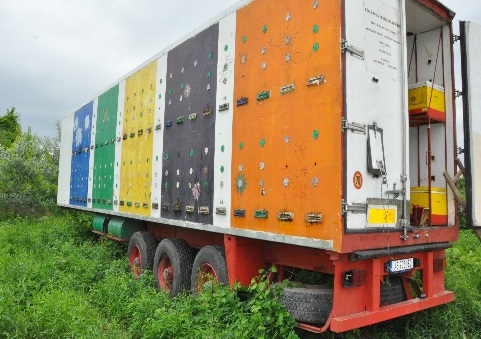The effect of food on the quality of artificially reared Apis mellifera queens ...
The effect of food on the quality of artificially reared Apis mellifera queens ...


The effect of food on the quality of artificially reared Apis mellifera queens
with evaluation of vitellogenin gene expression during development
I - Diet influence on the quality of produced queens
In the first part of the project the aim was to determine whether and how different diets can influence Apis mellifera queens by evaluation the acceptance of grafted queen cells, the quality of queen cells and body weight of the newly-emerged queens. In addition, brood pattern, the number of bees, mated queen weight, ovarian weight, the number of ovarioles and the diameter of spermatheca were estimated to investigate the effect of various diet types on mated queens. Twenty rearing colonies were assigned to four groups and fed on [1] sugar-only, [2] sugar (45%) with the addition of honey (30%) and pollen (25%), [3] sugar and a commercial pollen substitute (FeedBee®) and [4] natural sources (control group). Additionaly, a fifth group had queen cells obtained naturally, by swarming.
The number of accepted queen cells in each group was recorded. The dimensions (length, width and opening diameter) of 120 queen cells and the weight newly emerged queens were measured. Eight mated queens from each group were assessed. The following productive performances of these 40 queens were analysed: the brood patterns and the numbers of bees (on a frame) after four weeks were assessed. These queens were measured and dissected to determine the masses of the ovaries, numbers of ovarioles and the diameter of the spermatheca.
The data were processed by ANOVA and F test, and the differences between groups estimated with Duncan's Multiple Range Test (α=0.05) and the t-test. The correlation was estimated to be weak (Cv<0.3), medium (0.3<Cv<0.6) or strong (Cv>0.6). All statistical analyses were carried out with Statistica 8.0 software (StatSoft Inc.).
Queen cells acceptance rate in ‘sugar-only’ group was found to be significantly higher in comparison with that in control group. Diet also significantly affected queen cell length and body weight of newly-emerged queens. Queen cells from group fed on sugar and a commercial pollen substitute (FeedBee®) had the minimum length and were significantly shorter than those from ‘sugar-only’ and control groups. The highest average weight of newly-emerged queen was in ‘sugar-only’ and was significantly higher compared to other groups. There were no significant differences in queen cell opening diameter and width between the groups. These findings suggest the stimulating contribution of sugar to the acceptance rate and to the queens’ weight on emergence. Nevertheless, when mated, the queens from ‘sugar-only’ group were not superior to others by any quality or performance parameters (Dolasevic et al., 2019).
Having considered the mated queens in the current research, the best results were obtained in the group fed on mix of sugar, honey and fresh pollen, because queens from that group had significantly larger numbers of ovarioles in comparison with all the others. However, their body weight was significantly higher only than those originating from group fed on sugar and a commercial pollen substitute (FeedBee®) and those obtained by swarming. The queens from group fed on mix of sugar, honey and fresh pollen were also found to have significantly wider spermatheca in comparison with queens obtained by swarming. Queens obtained by swarming were not better in any trait in regard to the queens from control group, ‘sugar-only’ group and group fed on mix of sugar, honey and fresh pollen. Given the parameters monitored, FeedBee did not show positive influence on produced queens (Dolasevic et al., 2019).
II - Vitellogenin gene expression during development of the queens who were fed differently
The second part of the project was conducted in order to reveal whether the different diet provided to queen cell rearing colonies influences the expression of vitellogenin gene of obtained queens. Four groups of rearing colonies were established and fed on [1] sugar-only, [2] sugar (45%) with the addition of honey (30%) and pollen (25%), [3] sugar and a commercial pollen substitute (FeedBee®) and [4] natural sources (control group). Vitellogenin gene expression was determined in all developmental stages (eggs, larvae, prepupae, pupae and newly-emerged queens). Overall number of analysed samples was 112. From each sample individually the RNA was extracted with the Quick-RNA MiniPrep Kit (Zymo Research, USA). The total extracted RNA was immediately used to generate first strand cDNAs using the RevertAid™ First Strand cDNA Synthesis Kit (Fermentas, EU).
Reverse transcription-quantitative PCR (RT-qPCR) amplification was performed using SYBR green method in a 20 µl reaction mixture with the “KAPA SYBR® FAST Master Mix (2X) Universal“ (KAPA Biosystems, USA). Primers VgMC.f/r (Simone et al. 2009) were used (0.2 µM of each). The RT-qPCR reactions were carried out in 36-well rotor using “Rotor-Gene Q 5plex“ (Qiagen, Valencia, CA). Quantification of gene expression was done using 2−ΔΔCT method (Livak et al., 2001).For normalization of each gene expression β-actin was used as an internal control gene and median value of control group was used as a calibrator. For statistical analyses of the data, non-parametric (Kruskal-Wallis and Mann-Whitney U tests) were used.
The transcript levels of vitellogenin gene were not significantly different between groups suggesting no influence of different diet to the expression of the this gene. However, there were significant differences in transcript levels between developmental stages. The greatest level of vitellogenin expression was recorded in adult (newly-emerged) queens and the lowest in eggs. Transcription level of vitellogenin gene in adult queens was significantly higher compared to eggs and larvae, but not in comparison to prepupae and pupae. However, vitellogenin transcription in prepupae and pupae was significantly higher compared to eggs. These results provided better insight into the dynamics of vitellogenin gene expression during development of honey bee queens, the more so there was no previous research of vitellogenin gene expression in eggs.
III – Vitellogenin gene expression in queens who were produced in different ways
The third part of the project was conducted in order to examine if vitellogenin gene expression differs between mated queens produced in different ways. For that purpose, 40 queens (32 artificially produced and 8 obtained naturally, by swarming) were dissected after mating and their ovaria were taken for further analysis. RNA extraction, as well as cDNA synthesis, RT-qPCR amplification and quantification of gene expression were performed using the same methodology as already described in part II of this report. Comparison of the transcription level of the vitellogenin gene in ovaria of mated queens did not reveal significant differences between those obtained artificially and those produced naturally, by swarming. This finding suggests no effect of queen production method on vitellogenin gene expression, at least in their ovaria after mating.
Slobodan Dolašević
PhD candidate at the Faculty of Agriculture,
University of Belgrade, Belgrade-Zemun, SERBIA
References
- Dolasevic S, Stevanovic J, Aleksic N, Glavinic U, Deletic N, Mladenovic M, Stanimirovic M: The effect of diet on the quality of artificially reared Apis mellifera queens. Journal of Apicultural Research, 2019 (accepted for publication)
- Livak KJ, Schmittgen TD: Analysis of relative gene expression data using real-time quantitative PCR and the 2−ΔΔCT method, Methods 2001, 25: 402–408.
- Simone M, Evans J, Spivak M: Resin collection and social immunity in honey bees, Evolution 2009, 63: 3016–3022.
The results of this project were published in the Journal of Apicultural Research, 2019:
Slobodan Dolasevic, Jevrosima Stevanovic, Nevenka Aleksic, Uros Glavinic, Nebojsa Deletic, Mica Mladenovic & Zoran Stanimirovic (2019) The effect of diet types on some quality characteristics of artificially reared Apis mellifera queens, Journal of Apicultural Research, DOI: 10.1080/00218839.2019.1673965
https://doi.org/10.1080/00218839.2019.1673965
